Home >> Where fungi grow >> Parasites >> Fungal parasites of plants
FUNGAL PARASITES OF PLANTS
The study of plant disease, plant pathology, is a large and important one. Many universities have entire departments of plant pathology. The importance of the subject is obvious; since the beginning of agriculture humans have had to endure major crop losses because of disease. Even today, when crop health is under careful scrutiny, disease may suddenly strike and ruin an entire season's growth. It happens every year in some part of the globe, even in so-called developed nations.
Most plant diseases are caused by fungi; losses to bacteria and viruses are important, but less so than those caused by fungi. A great diversity of fungi cause plant disease, nearly all major groups are involved. In spite of these numbers there are just two types of parasite to consider: nectrotrophs and biotrophs. Necrotrophs are a little like predators; they kill the tissues they are about to consume before they eat them. Unlike predators, however, they don't normally kill the whole organism, just a part of it. They do this by means of toxins that diffuse out into the host tissues, killing the cells they encounter. The fungus then extends its hyphae into these killed areas and digests them. Biotrophs obtain their nutrition from living cells with which they may establish fairly long-lived associations. They usually penetrate the cell walls of their hosts and establish contact with the cell membrane by means of haustoria, cells specialized for the absorption of nutrients.
Plants do not just accept parasitic fungi. They have a large array of defense mechanisms that guard against fungal disease so that most fungi cannot get in. These defenses include physical barriers like the tough cuticle lining the surfaces of plants or the bark on trees. Chemical barriers including various toxins and strong oxidizers may be utilized. Fungi in their turn have developed ways of circumventing these defenses and seem to be able to develop new ones as soon as the plant confronts them. Some scientists have referred to this as a biological arms race. Plants differ greatly from one another in how they resist disease.
NECROTROPHS
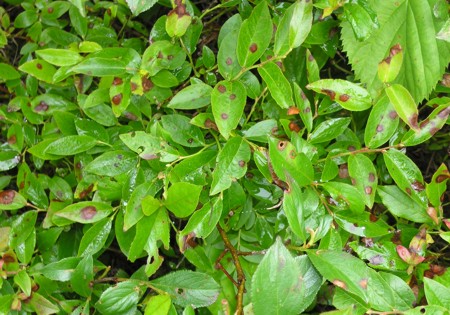
The plants in the photo at left are mainly blueberries but if you look closely you will also see chokeberries, raspberries and perhaps some other species. All are common in New Brunswick and are frequently infected by fungi. In this example the leaves are riddled with dead spots brought about by necrotrophic plant parasites. These range from small dark spots to larger dead areas, often ringed by discoloured dying zones. The fungi are within the spots, releasing toxins that kill the leaf cells and then spreading out into the killed areas.
Necrotrophic parasites are not always easy to characterize. At times such infections may be caused by biotrophic parasites that make such large nutritional demands on their host that they kill parts of it and thus resemble a necrotroph. However, biotrophs do not produce lethal toxins and they do not feed on dead tissues.
BIOTROPHS
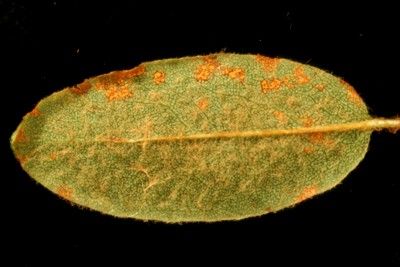
Because they do not produce toxins biotrophs may have longer and less damaging relationships with their hosts. In the figure at right the rust fungus Chrysomyxa ledi has formed several sites of sporulation on the underside of a leaf of Labrador tea. These areas of sporulation are confined within zones defined by veins. No yellowing or senescence of the host leaf due to this infection is visible although there appears to have been some damage from a necrotroph on the upper margin.
DIVERSITY OF PLANT PARASITIC FUNGI
Species of fungi causing plant disease can be found in nearly all taxonomic groups and will be encountered frequently in the section on classification. Instead we will examine diversity from a pathologist's point of view, focussing more on the disease than on the agent of the disease.
Roots
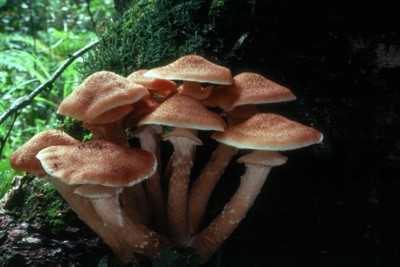
Plant roots are attacked by a great range fungi, from simple organisms parasitic on a single cell to ones attacking an entire root system. Many live inconspicuously in the root, inflicting little damage on the host. Others, such as the species of Armillaria at left, probably A. ostoyae, can attack entire root systems of trees, causing the whole plant to die. Armillaria species often grow harmlessly on the rotting wood various trees but under certain conditions can spread to living roots. This spread is accomplished by means of dark shoestring-like structures called rhizomorphs. When a rhizomorph of this fungus encounters a root it will penetrate and begin to develop between the wood and the bark, eventually colonizing up to the root collar (the part of the trunk where the roots arise. The growth beneath the bark forms a white mat of mycelium that will eventually kill the tree. Armillaria root rot is a major forest disease that particularly affects young conifers, such as those planted during reforestation efforts or in Christmas tree plantations. Dr. James Worrall has produced a beautifully illustrated Forest Pathology web site covering this and many other aspects of forest disease. Highly recommended.
Damping off
Damping off disease falls somewhere between root and stem diseases and is important enough to be considered on its own. The symptoms are known to anyone who has attempted to grow plants. The disease is caused by fungi living in the soil and develops on parts of the plants at the soil-air interface. Affected plants become greatly weakened at this point and are no long able to stand. Damping off is usually a "chilhood disease", affecting seedlings or very young plants. In natural ecosystems a high percentage of seedlings may succumb to damping off.
Leaves
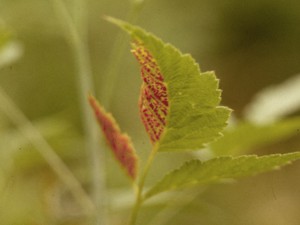
Leaves are rich in sugars and other products of photosynthesis and are prime targets for fungal parasites. Necrotrophic leaf spots discussed above are one kind of leaf infection. Biotrophic fungi may also attack leaves, sometimes causing a great deal of damage. The picture at right shows a raspberry leaf heavily infected with a species of Phragmidium, one of the rust fungi. Although they are biotrophs, species of Phragmidium can infect raspberries so severely that the plant is killed. Cultivated raspberries are usually propagated from resistant varieties but their wild relatives can be highly susceptible. The leaves of many cultivated as well as wild plants become infected with rust fung. These can be found easily in most parts of the world.
Flowers
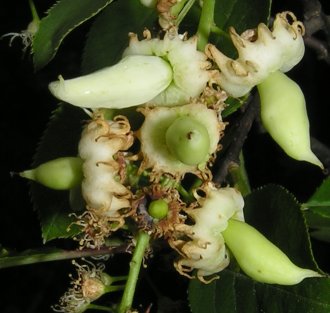
It is not unusual to find flowers affected by fungal parasites. In some cases flowers are colonized by fungi that cause no symptoms and seems to exist harmlessly in the plant. Often fungi of this sort can be found producing their spores on fallen flowers of the previus year and to be timed precisely to the opening of the current season's flowers. Other fungi cause conspicuous symptoms in the flowers they infect, as is the case of Taphrina confusa shown at left. Taphrina confusa infects the flowers, and sometimes the leaves, of chokecherry, causing them to become greatly distorted. Compare the large oversized infected flowers with uninfected ones on the stem at the bottom of the picture. The large green inflated parts are the ovaries of the flower and the white collar-like parts below them are the fused and greatly distorted anthers. Thus both male and female parts of the flower are affected. These enlarged flowers, sometimes called "pocket plums", can be found on chokecherry throughout much of its range. The genus Taphrina contains a large number of species, all parasitic on plants. Some, like T. confusa, infect flowers, but other are found primarily on leaves. Pictures of other Taphina species can be seen in the section on Hemiascomycetes.
Stems
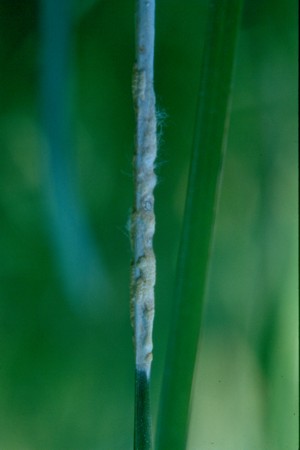
Although their main function in a plant is support, stems contain sufficient nutrients to attract a variety of parasitic fungi. Delicate structures, such as the stems or culms of grasses may be affected but stem diseases can also occur on the trunks of large trees. The picture at left shows a stem of Calamagrostis canadensis with choke disease, an infection caused by Epichloe typhina. The fungus lives within the stem of this grass and bears its spores on the brightly coloured collar it produces at the surface. The grass culm, along with its flowers, is eventually killed above the collar but the rest of the plant appears to be unaffected.